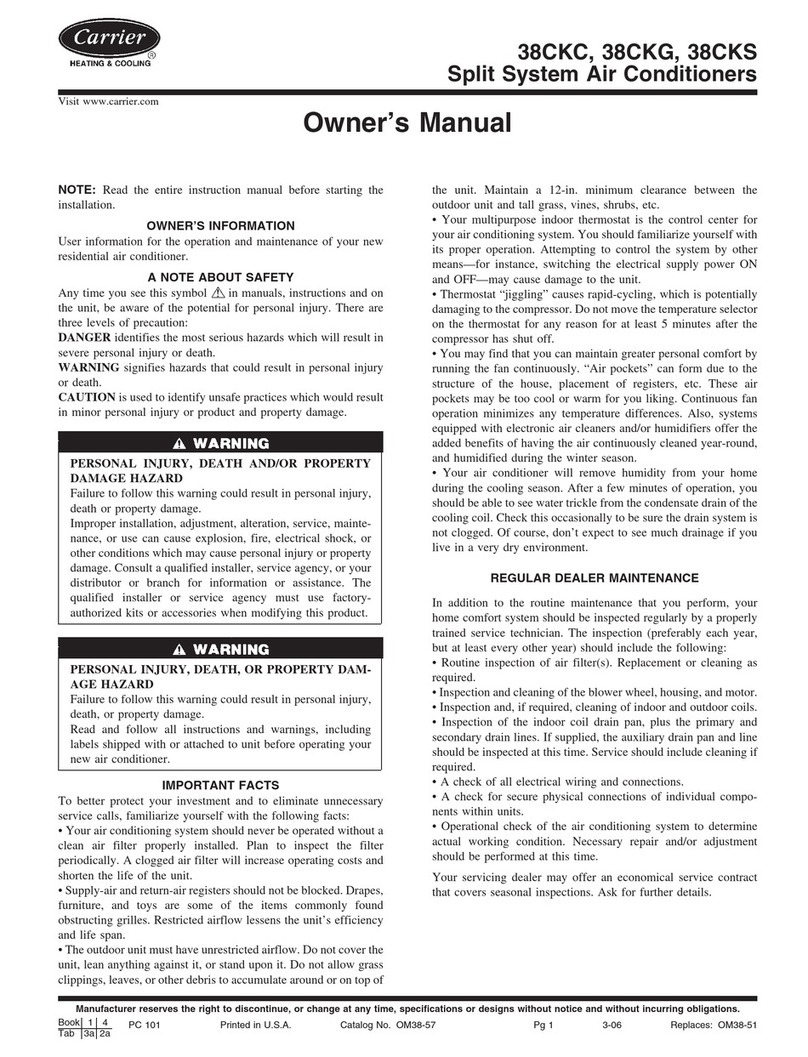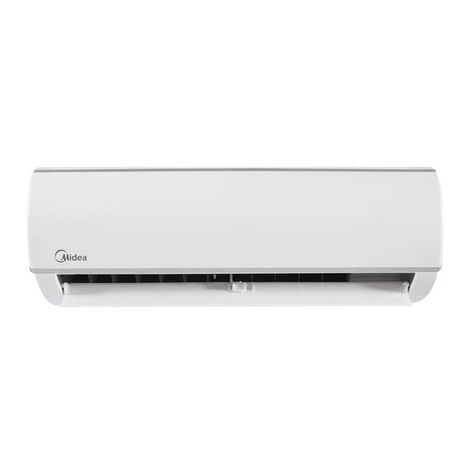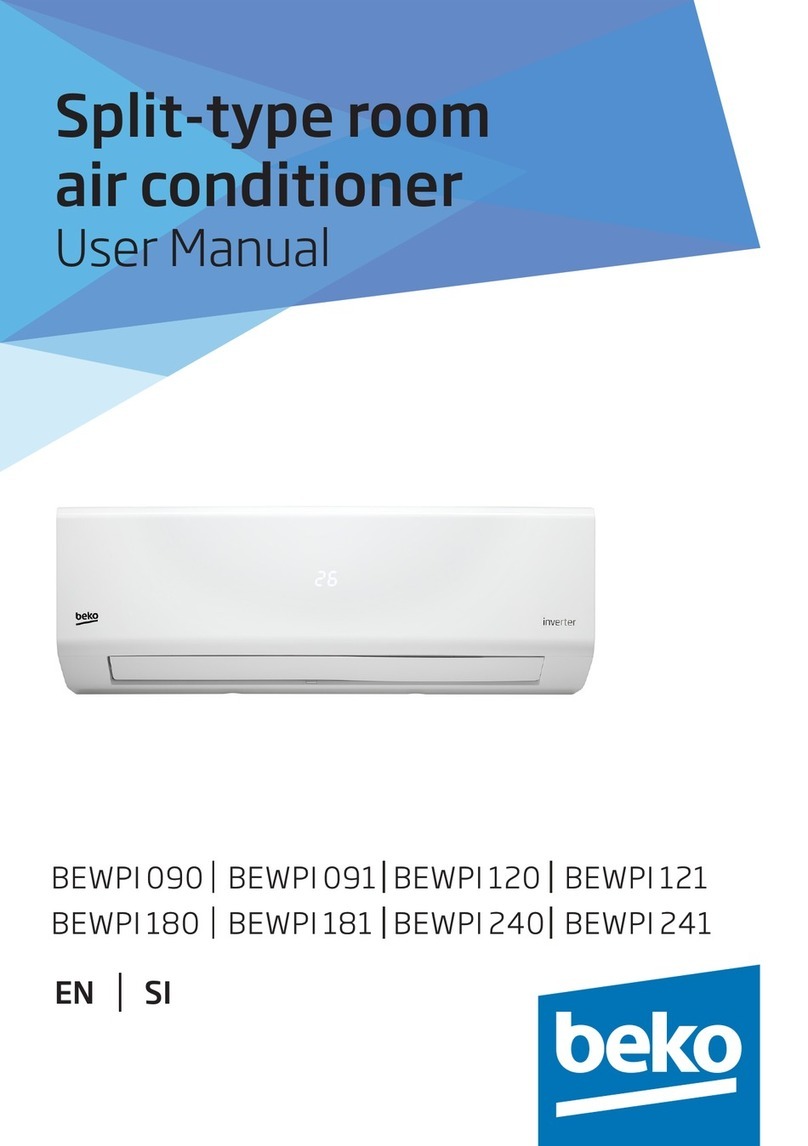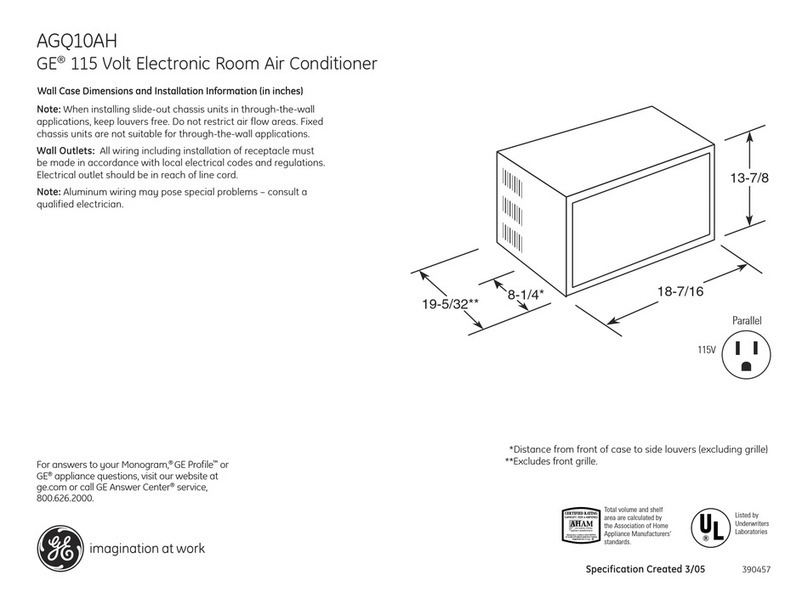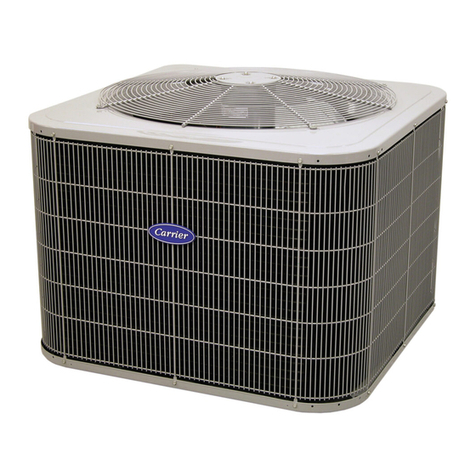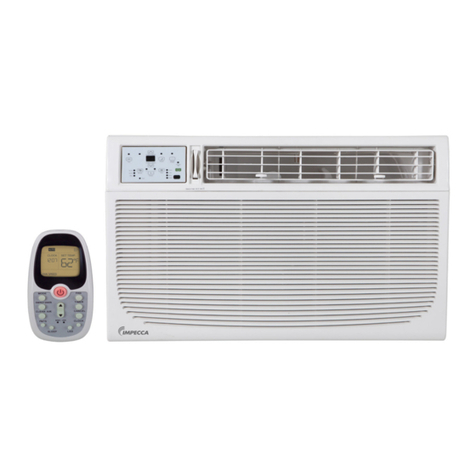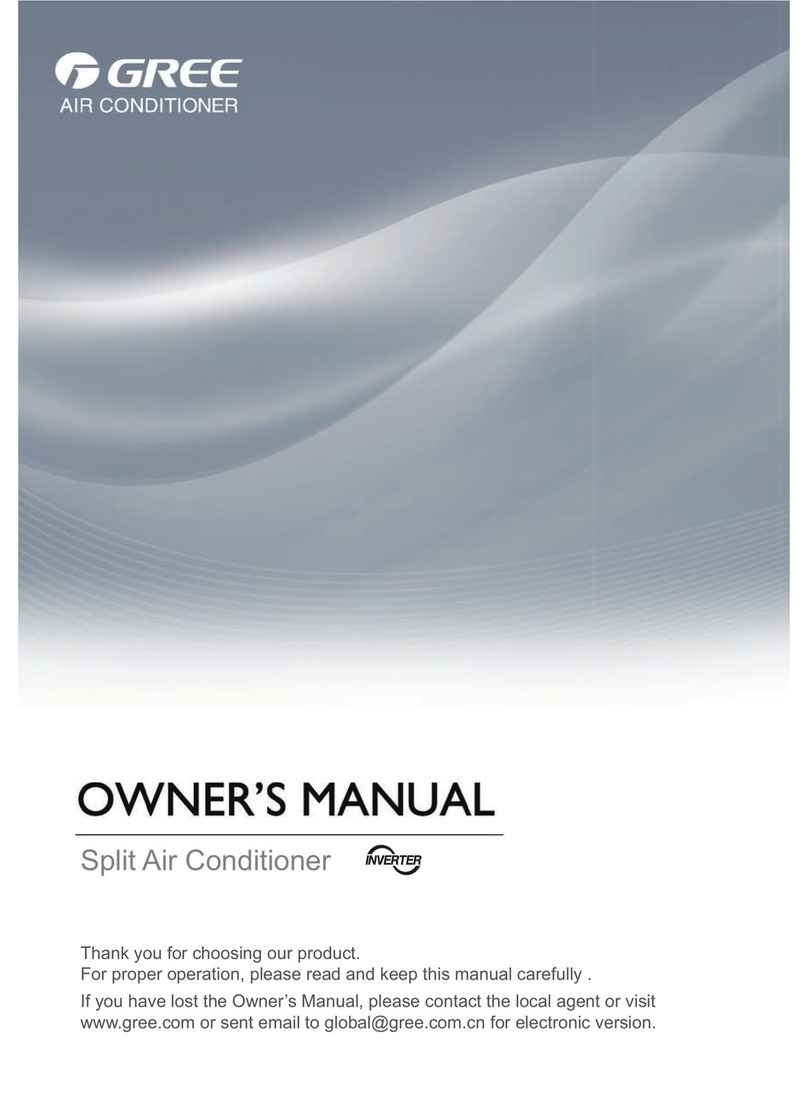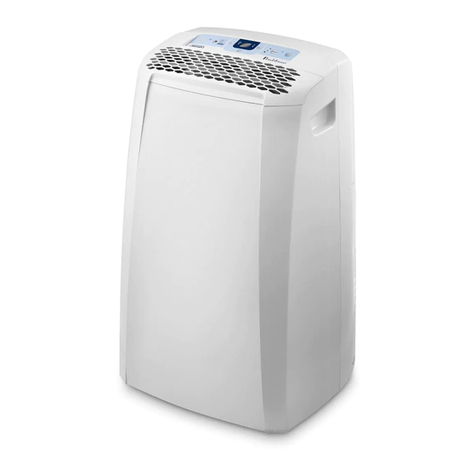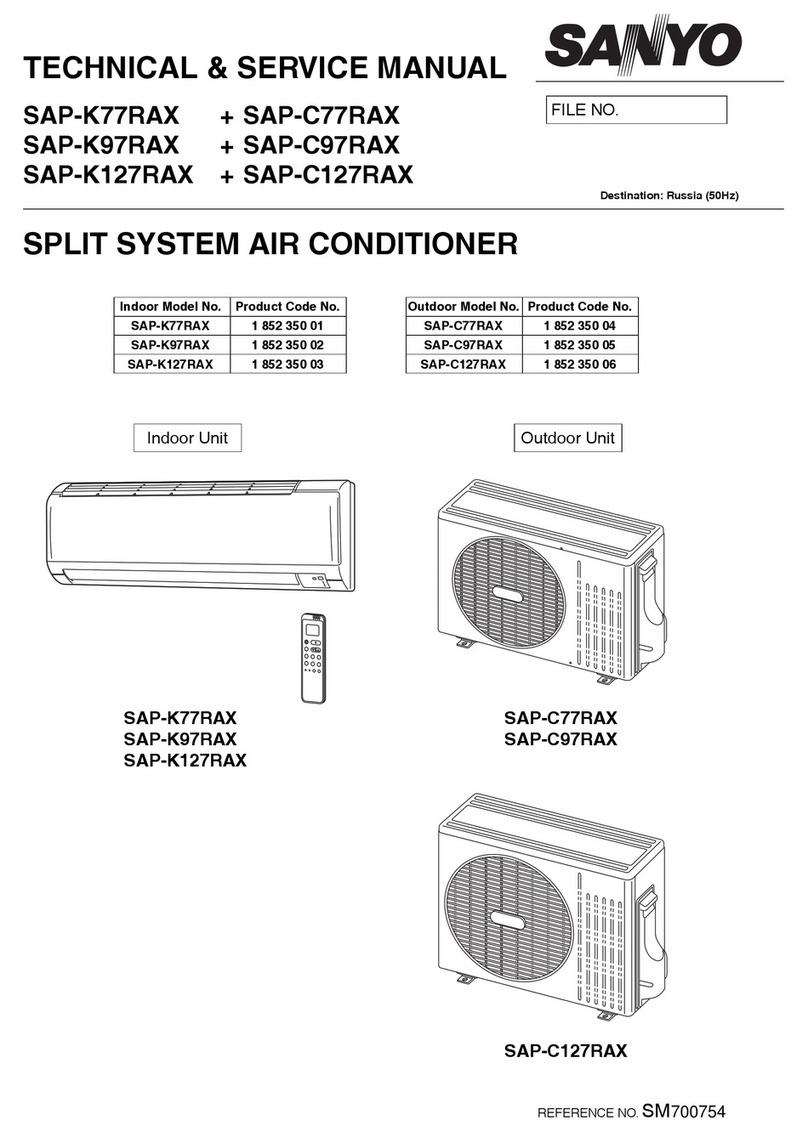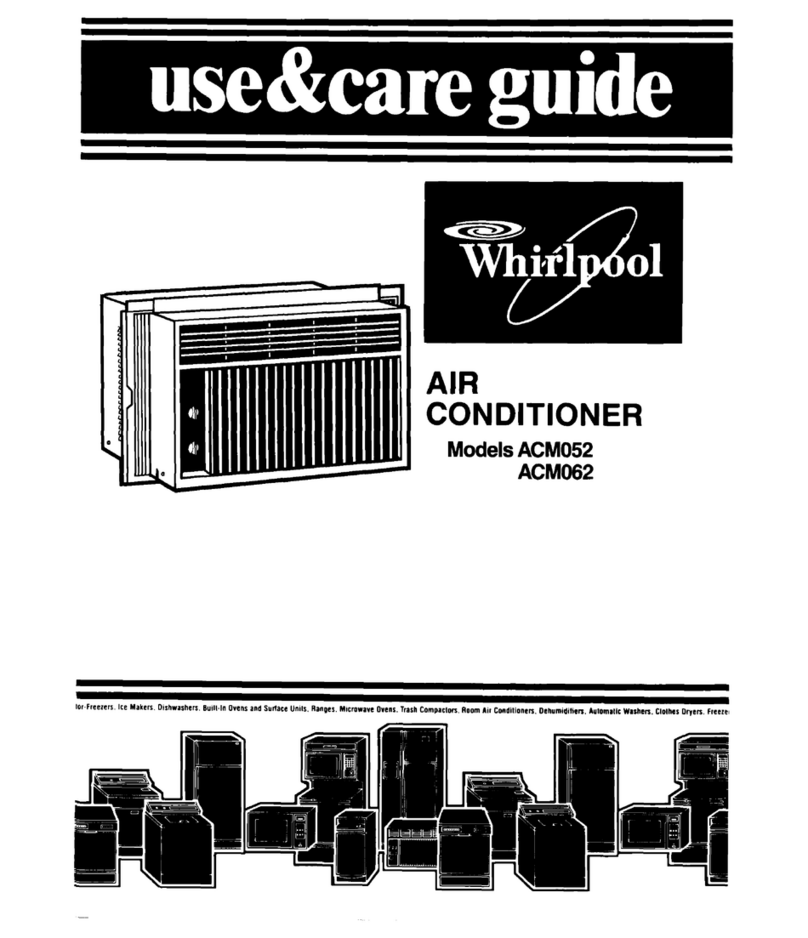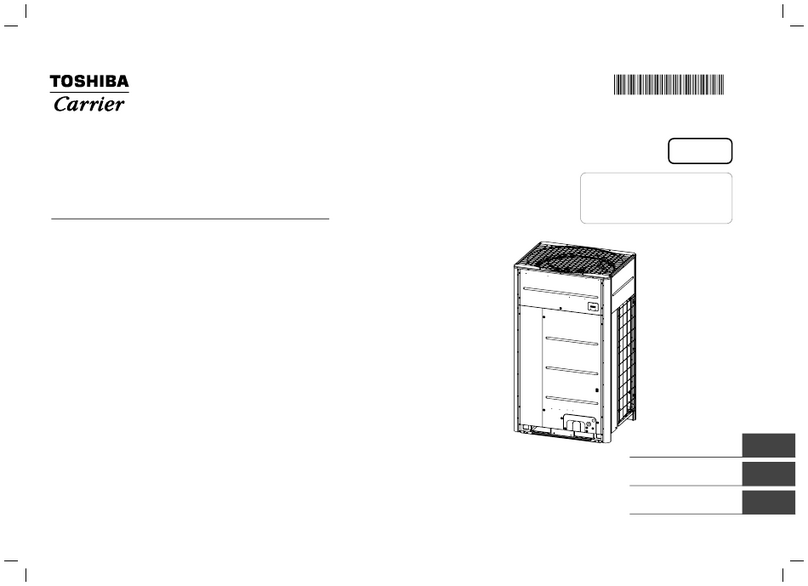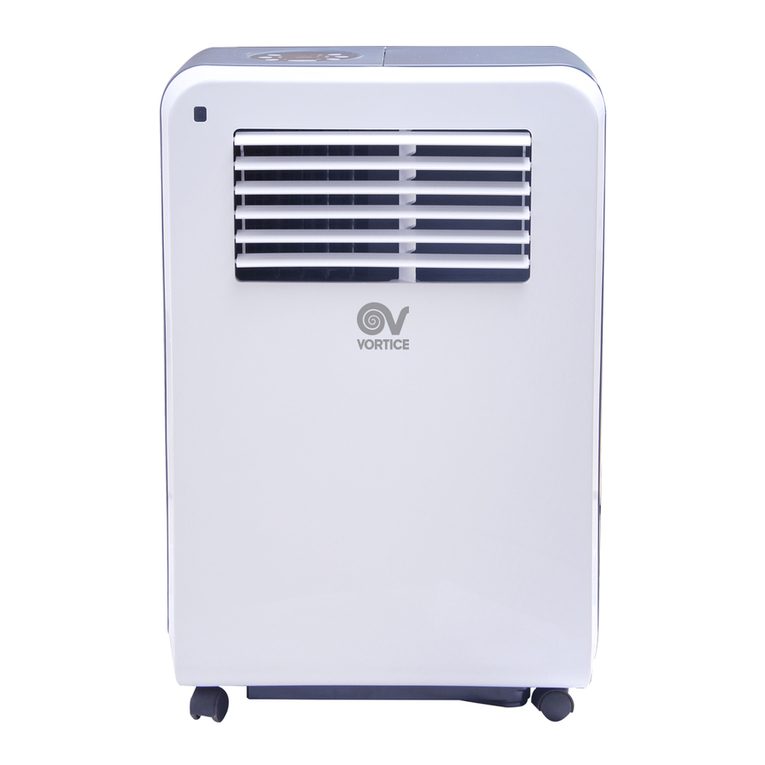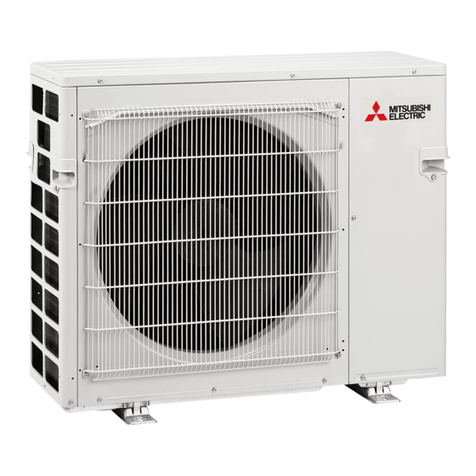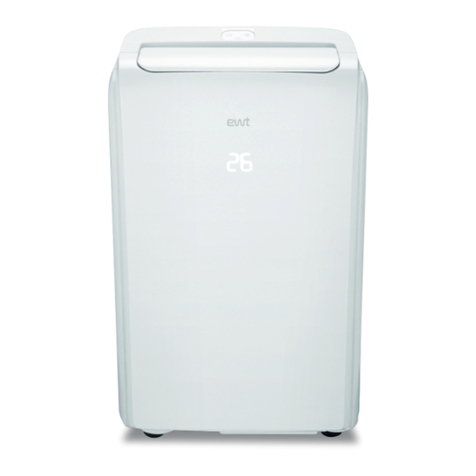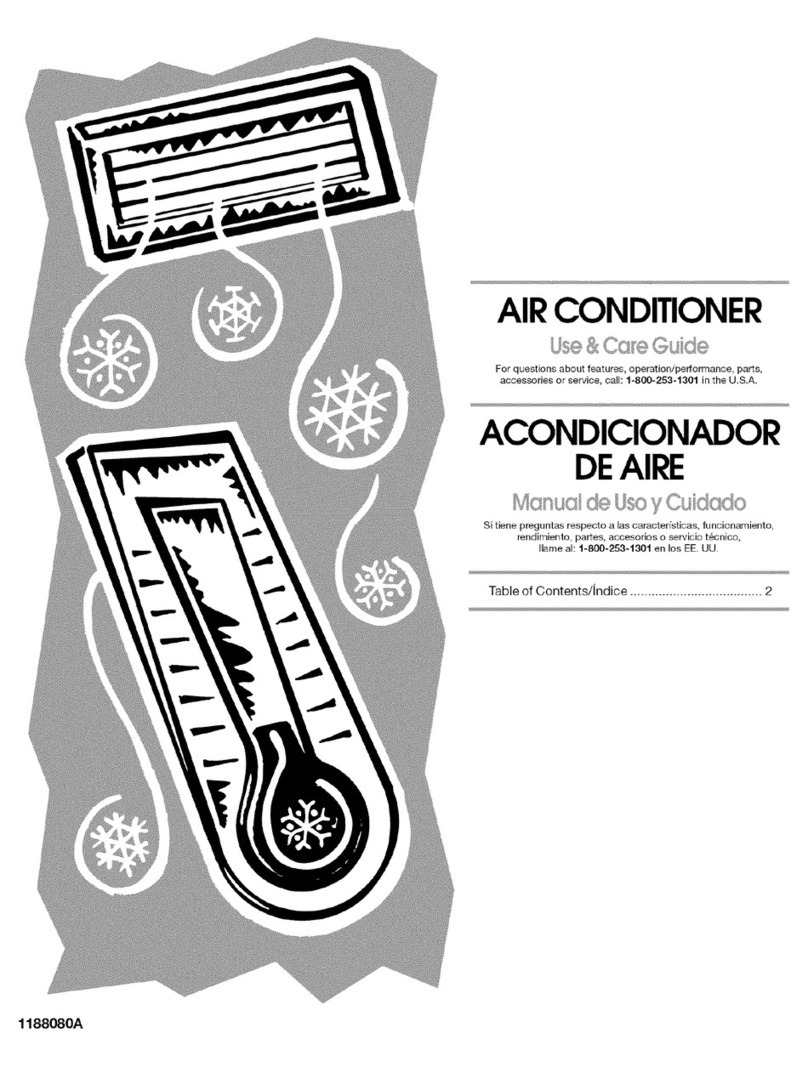Addison PR Series User manual

NOT FOR RESIDENTIAL USE
NOTICE
Installer:
Please take the time to read and understand the
instructions contained inside this manual prior to
any installation. The installer must give a copy of this
manual to the unit owner.
Owner:
Keep this manual in a safe place in order to provide
service technicians with necessary unit information.
Packaged
Rooftop DOAS &
Recirculation Unit
Installation, Operation,
& Maintenance Manual
PR**036 PR**048
PR**060 PR**072
PR**084 PR**096
PR**120 PR**150
PR**180 PR**210
PR**240 PR**300
PR**360 PR**420
PR**480 PR**540
PR**600 PR**720
PR**780 PR**840
PR Series

This Page is Intentionally Blank

Page 3 of 84
Table of Contents:
SECTION 1: Safety Introduction and Labeling Guide
Warnings, Dangers, Cautions, and Notices...................5
Label Placement Guide .......................................................... 6
Sample Unit Data Plate............................................................7
SECTION 2: Introduction and Pre-Installation
2.1 Description of Operation ................................................. 8
2.2 Inspection and Setup....................................................... 8
2.3 Unit Nomenclature Example .........................................9
SECTION 3: Installer Responsibility
Introduction .................................................................................13
3.1 Corrosive Chemicals.........................................................13
3.2 Required Equipment and Materials.........................13
SECTION 4: Critical Considerations
4.1 Required Clearances ........................................................14
4.2 Unit Placement Considerations.................................15
4.3 Hardware...............................................................................15
SECTION 5: National Standards and Applicable Codes
5.1 Refrigerant Handling Practices ...................................16
5.2 Installation Codes .............................................................16
5.3 Aircraft Hangers.................................................................16
5.4 Parking Structures and Repair Garages................16
5.5 Electrical ................................................................................16
SECTION 6: Lifting a Packaged Rooftop Unit
6.1 Moving/Lifting The Unit..................................................17
6.1 Moving the Unit with a Forklift ....................................17
6.1 Lifting the Unit with a Crane.........................................17
SECTION 7: Unit Placement.........................................................21
SECTION 8: Ductwork
Considerations ..........................................................................22
8.1 Return Air Ductwork ........................................................22
8.2 Discharge Ductwork.......................................................22
SECTION 9: Refrigeration Circuits and Piping
9.1 Refrigerant ............................................................................23
9.2 Components and Configurations.............................23
SECTION 10: Energy Recovery/Conservation Wheels
10.1 Principal of Operation....................................................29
SECTION 11: Gas Heater Packages
11.1 Principle of Operation.....................................................30
11.2 Gas Piping and Pressure.............................................30
11.3 Operating and Safety Controls..................................31
11.4 Wiring .....................................................................................31
11.5 Sequence of Operation..................................................31
SECTION 12: Electric Heater Packages
12.1 Principle of Operation ...................................................38
12.2 Operating and Safety Controls................................38
12.3 Wiring...................................................................................38
SECTION 13: Unit Electrical
13.1 Wiring and Electrical Connections ..........................41
13.2 Disconnect..........................................................................41
13.3 Current Draw.....................................................................41
13.4 Wiring Connections........................................................41
13.5 Voltage Unbalance .........................................................41
13.5 Low Voltage Wiring........................................................41
SECTION 14: Sequence of Operation
14.1 Unit Configuration............................................................51
14.2 Controls Options..............................................................51
14.3 Basic Sequence of Operation ..................................52
14.4 Accessory Controls Options.....................................52
SECTION 15: Start-Up Procedure
15.1 Tools & Supplies Requires ..........................................53
15.2 Pre-Start Checks............................................................53
15.2 Pre-Start Form.................................................................57
SECTION 16: Start-Up Procedures
Start-Up Form............................................................................60
SECTION 17: Unit Maintenance
Installation Code and Quarterly Inspections .............66
17.1 General .................................................................................. 67
17.2 Unit Exterior....................................................................... 67
17.3 Direct-Drive Supply and Exhaust Fans................ 67
17.4 Condensing Fans ............................................................ 67
17.5 Refrigeration Circuit Components.......................... 67
17.6 Condensate Drain Pan and Drain........................... 67
17.7 Dampers............................................................................... 67
17.8 Electric Heater Wiring and Wiring Conn............. 67
17.9 Filters..................................................................................... 67
SECTION 18: Replacement Parts.............................................68
SECTION 19: Troubleshooting
Supply Fan....................................................................................71
Compressor ................................................................................ 72
Refrigeration Circuit ............................................................... 74
Variable Speed Head Pressure Control........................ 76
Energy Conservation Wheel...............................................78
Gas Furnace ...............................................................................79
Electric Heater...........................................................................80
SECTION 20: Addison Warranty ...............................................81
Revision Guide ....................................................................................83
PR Series Installation, Operation, and Maintenance Manual

Page 4 of 84
Table of Figures:
Figures:
Figure 1: Label Placement Drawing.................................. 6
Figure 2: Sample Unit Data Plate .......................................7
Figure 3: Large Unit Lifting..................................................18
Figure 4: Medium Unit Lifting.............................................19
Figure 5: Small Unit Lifting .................................................20
Figure 6: Roof Curb Installation.........................................21
Figure 7: Circuit Diagram for Standard Compressor .
with Hot Gas Bypass and No Hot Gas Reheat .........24
Figure 8: Circuit Diagram for Standard Compressor
with Hot Gas Bypass and Modulating Hot Gas
Reheat ...........................................................................................25
Figure 9: Circuit Diagram for Digital Compressor
with Modulating Hot Gas Reheat ....................................26
Figure 10: Circuit Diagram for Standard Compressor
with Hot Gas Bypass and Modulating Hot Gas
Reheat and Subcooling ........................................................ 27
Figure 11: Circuit Diagram for Digital Compressor .....
with Modulating Hot Gas Reheat, and Subcooling 28
Figure 12: Example Energy Recovery Wheel .............29
Figure 13: Example Gas Heater Wiring Diagram -
5:1 Modulation ...........................................................................35
Figure 14: Example Gas Heater Wiring Diagram -
10:1 Modulation .........................................................................36
Figure 15: Example Gas Heater Wiring Diagram -
Dual Furnace.............................................................................. 37
Figure 16: Typical Electric Heater Wiring Diagram.40
Figure 17: Typical Electrical Wiring Diagram .............42
Figure 18: Phase Monitor Data..........................................49
Figure 19: Equipment Touch Display...............................51
Figure 20: P-Trap Configuration .......................................55
Tables:
Table 1: Recommended Torque Settings.......................15
Table 2: Manifold Size and Minimum Pressure ........30
Table 3: Standard Electric Heaters .................................39
Table 4: Low Voltage Wiring Lengths.............................41
Table 5: Condensate Connection Sizes........................54
Table 6: Hot Water Heating Coil Flow Rate ................56
Table 7: Superheat and Subcooling - 100% OA........56
Table 8: Superheat and Subcooling - Recirc .............56
Table 9: Superheat and Subcooling - Heat Pump...56
Table 10: Refrigerant Temperature-Pressure.............. 57
Table 11: Maintenance Guidelines.................................... 67
Table 12: Air Filters ..................................................................69
Table 13.1: Supply Fan .............................................................71
Table 13.2: Compressor......................................................... 72
Table 13.3: Refrigeration Circuit........................................ 74
Table 13.4: Variable Speed Heat Pressure Control.. 76
Table 13.5: Energy Conservation Wheel ....................... 78
Table 13.6: Gas Furnace........................................................79
Table 13.7: Electric Heater....................................................80
PR Series Installation, Operation, and Maintenance Manual

Page 5 of 84
Section 1:
Safety Introduction and Labeling Guide:
Your Safety is Important to Us!
Please follow and understand the rules and the
instructions contained herein carefully. Failure to do
so could cause a malfunction of the HVAC equipment,
resulting in injury, death and/or property damage.
Throughout this manual, and in specific places on the unit
itself, the signal words DANGER, WARNING and
CAUTION are used to identify levels of hazard
seriousness. NOTICE will be used in areas where there is
important information but not hazard related.
• DANGER – Immediate hazards which WILL result in
severe personal injury or death.
• WARNING – Hazards or unsafe practices which
COULD result in severe personal injury or death.
• CAUTION – Hazards or unsafe practices which
COULD result in minor personal injury or product or
property damage.
• NOTICE – Information to consider that might result in
poor operation, or equipment damage/failure.
DANGER
These instructions, local codes and ordinances and
applicable standards that apply to piping, electrical wiring,
ventilation, etc. must be thoroughly understood before
proceeding with the installation.
Protective gear is to be worn during installation,
operation and service in accordance to the Occupational
Safety and Hazard Administration (OSHA). Gear must
be in accordance to NFPA 70E, latest revision when
working with electrical components. Thin sheet metal
parts have sharp edges. To prevent injury, the use of
work gloves is recommended.
This equipment must be applied and operated under the
general concepts of reasonable use and installed using
best building practices.
This equipment is not intended for use by persons
(including children) with reduced physical, sensory or
mental capabilities, or lack of experience and knowledge,
unless they have been given supervision or instruction
concerning use of the equipment by a person responsible
for their safety.
Children should be supervised to ensure that they do not
play with the equipment.
To obtain additional copies of the Installation, Operation and
Maintenance Manual, please visit www.addison-hvac.com.
For detailed information regarding specifications,
dimensional drawings, and weight information, contact
your local Addison manufacturer’s representative.
DANGER labels will feature white text on a red background.
WARNING
WARNING labels will feature white text on an
orange background.
CAUTION
CAUTION labels will feature white text on a
yellow background.
NOTICE
NOTICE labels will feature white text on a
black background.
WARNING
Improper installation, service, or maintenance can
result in death, injury, or property damage. Read
this installation, operation, and maintenance manual
thoroughly before installing or servicing this equipment.
Installation must be done by a registered installer/
contractor qualified in the installation and service of
HVAC equipment.
PR Series Installation, Operation, and Maintenance Manual

Page 6 of 84
Figure 1: Label Placement Drawing
Part Number: Description: Location:
Brand Logo 1
Serial Data Plate 2
91070016 CA Prop 65 Label 3
91060002 R-410A Label 4
91070002 Fan Warning Label 5
Quality Inspection Stamp 6
9-21577 Hot Surface Label 7
0527N-0018 Condensate Trap Label 8
0527-0048 Copper Conductors Label 9
S-8238 Additional Parts Label 10
Electrical Warning Label 11
91031108 Door Latch & Lock Label 12
1
1
2
2
3
4
5
6
7
8
8
910
11
12
PR Series Installation, Operation, and Maintenance Manual

Page 7 of 84
Figure 2: Sample Unit Data Plate
Refrigerant Charge R410A Lbs. Kg. Volts Phase Low High
Circuit #1 18 8.18 460 3psig 250 490
Circuit #2 18 8.18 kPa 1724 3379
Volts
Phase
LRA Qty.
460 3100 1
Max 506
460 3100 1Min 414
Hz 60
Volts
Phase
HP Qty
Outdoor Fan (ea.) 460 31.27 1
Outdoor Fan (ea.) 460 31.27 145.1
Indoor Fan (ea.) 460 3 5 1
Exhaust Fan (ea.) 460 3 5 1
Wheel Motor (ea.) 460 30.5 150
Electric Heat kW VPhase Amp Stages
Gas heat Btu/h Input 5:1 Modulating NG
Minimum Clearance to Combustible Materials Inches
Short-circuit current: 5 kA ms symmetrical, 600 V maximum
Date of Manufacture: Jun-20
Manufacture Location:
Orlando, FL 32810 43136
(HACR Type)
Minimum Circuit Ampacity
1.6
300,000
6.3
Max. Circuit Protection
SUITABLE FOR OUTDOOR USE
1.6
Compressor(s) - Circuit #2
Compressor(s) - Circuit #1
Allowable Voltage
1.3
12.2
6.3
RLA
Test Pressure Max.
12.6
FLA
DOAS-4
PROA180C2B4D
Serial #
200300304001
Model #
Tag #
Unit Info.
Conforms to UL 1995 and ANSI Z83.8
Certified to CSA 22.2 No. 236 and CSA 2.6
Refrigerant Charge R410A Lbs. Kg. Volts Phase Low High
Circuit #1 25 11.36 460 3psig 250 490
Circuit #2 24 10.91 kPa 1724 3379
Volts
Phase
LRA Qty.
460 3100 1
Max 506
460 3100 1Min 414
Hz 60
Volts
Phase
HP Qty
Outdoor Fan (ea.) 460 31.27 1
Outdoor Fan (ea.) 460 31.27 137.5
Indoor Fan (ea.) 460 3 5 1
Exhaust Fan (ea.)
Wheel Motor (ea.) 50
Electric Heat kW VPhase Amp Stages
Gas heat Btu/h Input 10:1 Modulating NG
Minimum Clearance to Combustible Materials Inches
Short-circuit current: 5 kA ms symmetrical, 600 V maximum
Date of Manufacture: Jun-20
Manufacture Location:
Orlando, FL 32810 43136
(HACR Type)
Minimum Circuit Ampacity
1.6
500,000
Max. Circuit Protection
SUITABLE FOR OUTDOOR USE
1.6
Compressor(s) - Circuit #2
Compressor(s) - Circuit #1
Allowable Voltage
12.2
6.3
RLA
Test Pressure Max.
12.6
FLA
RT-2
PRRA180G2N4D
Serial #
200206701001
Model #
Tag #
Unit Info.
Conforms to UL 1995 and ANSI Z83.8
Certified to CSA 22.2 No. 236 and CSA 2.6
Before installation or service, the unit data plate similar to
the examples above should be found and consulted.
PR Series Installation, Operation, and Maintenance Manual

Page 8 of 84
Section 2:
Introduction and Pre-Installation:
2.1 - Description of Operation
The PR Series unit is a factory-assembled packaged
system that can operate within a broad range of ambient
conditions and introduce ventilation air into a building at
neutral conditions. It consists of matched refrigeration and
air moving components (system controls, compressor[s],
evaporator section, condensing section and fan[s])
designed to treat 100% outside air and/or recirculated
air. This system has the ability to filter, cool, heat, and/or
dehumidify air.
The unit may be provided with several dierent options
and/or controls to meet various application requirements,
including optional hot gas reheat, energy recovery wheel,
supplemental heat (gas, electric hot water or steam) and
variable air volume delivery. Be sure to read this entire
manual before installation and start-up.
2.2 Inspection and Setup
The unit was leak-tested, pressure-tested, evacuated,
charged and run-tested prior to shipment. Immediately
upon receipt of the unit, check the electrical supply and/
or fuel characteristics of the unit and verify that they
match the electrical supply and/or fuel available. Verify
that the specifications on the unit rating plate match
your order. Check the unit for any damage that may
have occurred during shipment. If any damage is found,
file a claim with the transporting agency. Do not refuse
shipment. Check the installation location to ensure proper
clearances. See Page 4, Section 3.
Any small options which do not come attached to the unit
(i.e. sensors) will be found inside the unit control enclosure.
If the unit must be temporarily stored (i.e. job site is not
ready for installation of the unit), the unit should be set
on 4" x 4" (10 cm x 10 cm) pieces of timber on the ground
in a protected area. The unit should be covered to be
protected from the environment.
WARNING
This unit contains HFC-(R410A), an azeotropic
mixture of R-32 (Difluoromethane) and R-125
(Pentafluoroethane). DO NOT VENT HFC-(R410A) to
the atmosphere. The U. S. Clean Air Act requires the
recovery of any residual refrigerant. Do not use R-22
service equipment or components on R410A systems.
NOTICE
California Proposition 65
In accordance with California Proposition 65
requirements, a warning label must be placed in a
highly visible location on the outside of the equipment
(i.e., near equipment’s serial plate). See label
placement drawings on Figure 1 for label location.
Avoid placing label on areas with extreme heat, cold,
corrosive chemicals or other elements. To order
additional labels, please contact Addison, or your
Addison independent distributor.
PR Series Installation, Operation, and Maintenance Manual

Page 9 of 84
2.3 - Unit Nomenclature Example
PR Series Installation, Operation, and Maintenance Manual
Digit: Description: Feature:
1 - 2 Product Family PR = Packaged Rooftop
3 Application
O = Dedicated Outdoor Air
M = Mixed Air (20% or Higher OA)
R = Recirculating
4 Operation Type A= Air Cooled
H= Air Source Heat Pump
5 - 7 Nominal Capacity
036 = 3.0 Tons
048 = 4.0 Tons
060 = 5.0 Tons
072 = 6.0 Tons
084 = 7.0 Tons
096 = 8.0 Tons
120 = 10.0 Tons
150 = 12.5 Tons
180 = 15.0 Tons
210 = 17.5 Tons
240 = 20.0 Tons
300 = 25.0 Tons
360 = 30.0 Tons
420 = 35.0 Tons
480 = 40.0 Tons
540 = 45.0 Tons
600 = 50.0 Tons
660 = 55.0 Tons
720 = 60.0 Tons
780 = 75.0 Tons
840 = 70.0 Tons
8 Cabinet Size
A= A Cabinet
B= B Cabinet
C= C Cabinet
K= CL Cabinet
G= CXL Cabinet
D= D Cabinet
H= DXL Cabinet
E= E Cabinet
J= EXL Cabinet
9 Controls
A= ALC, Standard Program, DOAS (E = with Lon)
B= ALC, Standard Program, DOAS with Recirculating NSB (F = with Lon)
C= ALC, Standard Program, Recirculating (G = with Lon)
D= ALC, Standard Program, with Economizer & Enthalpy (H = with Lon)
J= Controls by Others, Factory Mounted
K= Terminal Strip, Controls Provided and Mounted by Others
L= Remote Thermostat
M= Compressor Lockout Thermostat
10 Voltage
2= 208/60/3
3 = 230/60/3
4= 460/60/3

Page 10 of 84
2.3 - Unit Nomenclature Example, Cont.
PR Series Installation, Operation, and Maintenance Manual
Digit: Description: Feature:
12 Vintage D= Current
13 Airflow Orientation
A= Vertical supply and vertical return
B= Horizontal supply and vertical return
C= Vertical supply and side return
D= Horizontal supply and side return
E= Vertical supply and no return
F= Horizontal supply and no return
20 Compressor Type
0= None
1= Single Scroll/Single Circuit
2= Dual Scroll/Dual Circuit
3= Single Digital Scroll/Single Circuit (17.5 Tons and Below)
4= Single Digital Scroll and Single Scroll/Dual Circuit
6= Dual Scroll/Dual Circuit Lead VFD (17.5 Tons and Above)
22 - 23 Refrigeration Options
00 = None
AE = Hot Gas Bypass (Lead Circuit)
AF = Hot Gas Bypass (Lag Circuit)
AG = Hot Gas Bypass (Dual Circuit)
AK = Hot Gas Reheat, Modulating (Single Circuit)
AL = Hot Gas Reheat, Modulating (Dual Circuit)
AM = Liquid Subcooling, Switchable, All Circuits
DB = AE + AK
DV = AE + AL
DC = AE + AM
DT = AF + AK
DW = AF + AL
DZ = AF + AM
DU = AG + AK
DX = AG + AL
EU = AG + AM
DE = AK + AM
FB = AE + AK + AM
FJ = AF + AK + AM
FK = AG + AK + AM
24 Heating Type
0= None
A= Electric Heat
B= Natural Gas Heat
D= LP Gas Heat
F= Hot Water Heat
G= Electric Pre-Heat
H= B + G
J= D + G
K= F + G

Page 11 of 84
PR Series Installation, Operation, and Maintenance Manual
2.3 - Unit Nomenclature Example, Cont.
Digit: Description: Feature:
25 Electric Heating Capacity
0= None
A= 5kW 240/480/575V - 3.75kW 208V
B= 10kW 240/480/575V - 7.5kW 208V
C= 15kW 240/480/575V - 11.25kW 208V
D= 20kW 240/480/575V - 15kW 208V
E= 25kW 240/480/575V - 18.75kW 208V
F= 30kW 240/480/575V - 22.5kW 208V
G= 35kW 240/480/575V - 26.25kW 208V
H= 40kW 240/480/575V - 30kW 208V
K= 50kW 240/480/575V - 37.5kW 208V
M= 60kW 240/480/575V - 45kW 208V
N= 70kW 240/480/575V - 52.5kW 208V
P= 80kW 240/480/575V - 60kW 208V
R= 100kW 240/480/575V - 75kW 208V
S= 110kW 240/480/575V - 81.4kW 208V
T= 120kW 240/480/575V - 90kW 208V
U= 130kW 240/480/575V - 97.5kW 208V
V= 140kW 240/480/575V - 105kW 208V
W= 150kW 240/480/575V - 112.5kW 208V
26 - 27 Gas Heating Capacity
00 = None
A1 = 75MBH
B1 = 100MBH
C1 = 150MBH
D1 = 200MBH
E1 = 250MBH
F1 = 300MBH
G1 = 350MBH
H1 = 400MBH
J1 = 500MBH
K1 = 600MBH
A2 = 100+100MBH
G2 = 150+150MBH
B2 = 200+200MBH
C2 = 250+250MBH
D2 = 300+300MBH
F2 = 350+350MBH
E2 = 400+400MBH
H2 = 500+500MBH
J2 = 600+600MBH
A4 = (4) 200MBH
B4 = (4) 250MBH
C4 = (4) 300MBH
D4 = (4) 350MBH
E4 = (4) 400MBH

Page 12 of 84
PR Series Installation, Operation, and Maintenance Manual
2.3 - Unit Nomenclature Example, Cont.
Digit: Description: Feature:
28 Heater Control
0= None
1= 1 Stage
2= 2 Stage
3= 4 Stage
9= 8 Stage
4= SCR (N/A 5kW)
6= Modulating 5:1 NG, 3:1 LPG
7= Modulating 10:1 NG, 6:1 LPG
8= Modulating 20:1 NG, 12:1 LPG
30 Energy Recovery
0= None
B= ECW 324+2” 30/30 Filter
C= ECW 364+2” 30/30 Filter
D= ECW 424+2” 30/30 Filter
E = ECW 484+2” 30/30 Filter
F= ECW 544+2” 30/30 Filter
G= ECW 604+2” 30/30 Filter
J= ECW 606+2” 30/30 Filter
K= ECW 664+2” 30/30 Filter
L= ECW 666+2” 30/30 Filter
M= ECW 706+2” 30/30 Filter
N= ECW 724+2” 30/30 Filter
P= ECW 726+2” 30/30 Filter
Q= ECW 784+2” 30/30 Filter
R= ECW 786+2” 30/30 Filter
S= ECW 7812+2” 30/30 Filter
T= ECW 844+2” 30/30 Filter
U= ECW 846+2” 30/30 Filter
V= ECW 8412+2” 30/30 Filter
31 Energy Recovery Options
0= None (No ECW)
A= On/O Defrost
B= VFD Temp Defrost
C= Bypass
D= A + C
E= B + C
F= Standard Control
G= C + F
H = VFD (Used only with CBO’s)
J= C + H
38 - 39 Corrosion Protection
00 = None
A1 = Cabinet
F1 = Condenser Coils
G1 = CuproNickel Water Coil
H1 = Internal Coils

Page 13 of 84
Section 3:
Installer Responsibility:
The installer is responsible for the following:
• To install and commission the unit, as well as the
fuel and electrical supplies, in accordance with
applicable specifications and codes. Addison
recommends the installer contact a local building
inspector for guidance.
• To use the information given in a layout drawing and
in the manual together with the cited codes and
regulations to perform the installation.
• To furnish all needed materials not furnished as
standard equipment.
• To plan location of supports.
• To provide access to unit for servicing.
• To provide the owner with a copy of this Installation,
Operation and Service Manual.
• To ensure there is adequate air circulation around the
unit and to supply air for combustion, ventilation and
distribution in accordance with local codes.
• To assemble or install any accessories or associated
duct work using best building practices.
• To properly size supports and hanging materials.
• To verify that the unit is delivering design airflow by
having an air balancing test performed.
• To have refrigerant technician certification per
Section 608 of the US Environmental Protection
Agency (EPA) Clean Air Act of 1990 or equivalent
certification program.
• To have all required equipment to work on direct
expansion and/or chilled water air conditioning system.
3.1 Corrosive Chemicals
Addison cannot be responsible for ensuring that all
appropriate safety measures are undertaken prior to
installation; this is entirely the responsibility of the installer.
It is essential that the contractor, the subcontractor, or the
owner identifies the presence of combustible materials,
corrosive chemicals or halogenated hydrocarbons*
anywhere in the premises.
* Halogenated Hydrocarbons are a family of chemical compounds
characterized by the presence of halogen elements (fluorine,
chlorine, bromine, etc.). These compounds are frequently used in
refrigerants, cleaning agents, solvents, etc. If these compounds
enter the air supply of the burner, the life span of the unit
components will be greatly reduced. An outside air supply must
be provided to the burners whenever the presence of these
compounds is suspected. Warranty will be invalid if the unit is
exposed to halogenated hydrocarbons.
WARNING
EXPLOSION HAZARD
Equipment must have access to
uncontaminated air at all times.
Failure to follow these instructions
can result in death, injury, or
property damage.
CAUTION
PRODUCT DAMAGE HAZARD
Do not use equipment in area
containing corrosive materials.
Refer to appropriate Material
Safety Data Sheets (MSDS).
Failure to follow these instructions
can result in product damage.
3.2 Required Equipment and Materials
When lifting of the unit is required, the installing
contractor is responsible for supplying or arranging for
the appropriate lifting equipment so that the unit may be
placed in a safe manner.
The qualified installing / service technician is responsible
for having the appropriate equipment and materials for the
safe installation and start-up of an unit. Tools and materials
required to commission the unit include, but are not limited
to, the following:
• Various screwdriver types and sizes
• Various wrench types and sizes
• Drill motor and various drill bits
• Voltmeter
• Clamp style ammeter
• Butyl caulk
• Gauges and accessories
• Direct expansion and/or chilled water gauges
and accessories.
PR Series Installation, Operation, and Maintenance Manual

Page 14 of 84
Section 4:
Critical Considerations:
4.1 Required Clearances
Clearances are the required distances that the unit must
be away from objects and other units to allow service
access and proper operation of the unit.
TOP VIEW
A
C
B
D
Cabinet: A B C D
A50” 48” 41” 48”
B56” 48” 41” 48”
C62” 48” 44” 48”
D80” 48” 56” 48”
E104” 48” 56” 60”
Minimum clearance required for side
removal of energy recovery wheels and/or
DX coils.
PR Series Installation, Operation, and Maintenance Manual

Page 15 of 84
4.1.1 Service Clearances
Minimum service clearance for service is based on
cabinet size described in section 4.1.
4.1.2 Ventilation Clearances
In order to help ensure proper operation of an air-source
constructed unit, a 24" (61.0 cm) clearance for ventilation
must be maintained.
In addition, read and follow the additional ventilation
clearance guidelines below:
• Do not locate the unit under an overhang or near a
wall/other equipment that will short circuit hot air to
the coil intakes.
• Do not locate unit within 10’ (3.0 m) of exhaust fans
or flues.
• Do not locate the unit too close to another unit to
allow air recirculation.
4.2 Placement Considerations
The unit is typically mounted on a curb with ductwork
and utility connections usually going through the curb. It
may also be pad-mounted. (Contact factory for specific
instructions if unit is to be mounted in a dierent way [ie.
on mounting stand].)
Select a location where external water drainage cannot
collect around the unit. Locate the unit so roof runo
water does not pour directly on the unit. Provide gutter or
other shielding at roof level. Where snowfall is anticipated,
mount the unit so all intakes and discharges are above
the maximum snow depth for the area. Unit shall not
be installed with inlet opening facing into the prevailing
wind direction in order to help prevent the possibility of
moisture entrainment.
When installed at ground level, the unit should be
mounted on a level concrete slab which should extend at
least 2" (5.1 cm) beyond the unit on all sides. The top of
the slab should be 2" (5.1 cm) above the ground level. The
depth of the slab below the ground level and its structural
design is governed by the type of soil and climatic
conditions. The slab must not be in contact with any part
of the building wall or foundation. The space between
the slab and the building wall prevents the possibility of
transmitting vibration to the building.
When installing a unit on the roof of a building, the
structural members supporting the unit must be suiciently
strong for the weight of the unit and mounting rails.
4.3 Hardware
Unless otherwise specified, all hardware (except sheet
metal screws) must be torqued to settings from Table 1.
Table 1: Recommended Torque Settings
8.8 10.9
8.8 10.9
Bolt Head
Grade Marking
Nut
Grade Marking
Bolt Size: Grade 2: Grade 5:
10-24 27 in-Lb 42 in-Lb
1/4-20 65 in-Lb 101 in-Lb
5/16-18 11 ft-Lb 17 ft-Lb
3/8-16 19 fl-Lb 30 ft-Lb
8.8 10.9
8.8 10.9
Bolt Head
Grade Marking
Nut
Grade Marking
Bolt Size: Grade 2: Grade 5:
M5 6Nm 9Nm
M6 10Nm 15Nm
M8 25Nm 35Nm
M10 50Nm 75Nm
M12 85Nm 130Nm
M16 215Nm 315Nm
PR Series Installation, Operation, and Maintenance Manual

Page 16 of 84
Section 5:
National Standards and
Applicable Codes:
5.1 Refrigerant Handling Practices
The handling, reclaiming, recovering and recycling of
refrigerants as well as the equipment to be used and the
procedures to be followed must comply with the national
and local codes.
United States: Refer to Federal Clean Air Act -
latest revision.
Canada: Refer to Canadian Environmental Protection Act
- latest revision.
5.2 Fuel Codes
The type of fuel appearing on the nameplate must be the
type of fuel used. Installation must comply with national and
local codes and requirements of the local fuel company.
United States: Refer to NFPA 54/ANSI Z223.1 - latest
revision, National Fuel Gas Code.
Canada: Refer to CSA B149.1 - latest revision, Natural Gas
and Propane Installation Code.
5.3 Installation Codes
Installations must be made in accordance with NFPA
90A - latest revision, Standard for the Installation of Air-
Conditioning and Ventilation Systems.
5.4 Aircraft Hangars
Installation in aircraft hangars must be in accordance with
the following codes:
United States: Refer to Standard for Aircraft Hangars,
NFPA 409 - latest revision.
Canada: Refer to Standard CSA B149.1 - latest revision,
Natural Gas and Propane Installation Code.
5.5 Parking Structures and Repair Garages
Installation in garages must be in accordance with the
following codes:
United States: Standard for Parking Structures NFPA 88A
- latest revision or the Code for Motor Fuel Dispensing
Facilities and Repair Garages, NFPA 30A - latest revision.
Canada: Refer to CSA B149.1 - latest revision, Natural Gas
and Propane Installation Code.
5.6 Electrical
Electrical connection to unit must be in accordance with
the following codes:
United States: Refer to National Electrical Code®, NFPA 70
- latest revision. Wiring must conform to the most current
National Electrical Code®, local ordinances, and any
special diagrams furnished.
Canada: Refer to Canadian Electrical Code, CSA C22.1
Part 1 - latest revision.
5.7 Venting
The optional gas furnace in the unit must be vented in
accordance with the requirements within this manual and
with the following codes and any state, provincial or local
codes which may apply:
United States: Refer to NFPA 54/ANSI Z223.1- latest
revision, National Fuel Gas Code.
Canada: Refer to CSA B149.1 - latest revision, Natural Gas
and Propane Installation Code.
5.8 High Altitude
The optional gas furnace in the unit is approved for
installations up to 2000' [609.6 m] US, 4500' [1371.6 m]
[Canada] without modification. Consult factory if US
installation is above 2000' (609.6 m) or Canadian
installation is above 4500’(1371.6 m).
PR Series Installation, Operation, and Maintenance Manual

Page 17 of 84
Section 6:
Lifting a Packaged Rooftop Unit: WARNING
CRUSH HAZARD
Use proper lifting equipment and
practices. Failure to follow these
instructions can result in death,
injury, or property damage.
The unit must be installed in compliance with all
applicable codes. The qualified installer or service
technician must use best building practices when
installing the unit.
6.1 Moving/Lifting a Packaged Air
Conditioning Unit
6.1.1 Preparing to Move/Lift the Unit:
Prior to moving/lifting the unit, the following steps must
be performed.
1. Remove all packaging or blockers.
2. Remove all packages that were shipped inside
the unit.
3. Inspect the unit to:
• Verify that there is no damage as a result
of shipping.
• Ensure that it is appropriately rated for the utilities
available at the installation site.
• Verify that the lifting lugs are intact, undamaged
and secured to the packaged air conditioning unit.
• Ensure factory-installed hardware is torqued
as specified.
4. Prepare the installation location to be ready to accept
the unit (i.e. roof curb is correct size).
5. Verify that the moving/lifting equipment can handle the
unit’s weight. Verify that forklift forks extend through
the unit frame and that crane has required reach.
6.1.2 Moving the Unit with a Forklift
On smaller A, B, and some C cabinet units, forklift pockets
are provided for lifting and moving. The following must be
considered before using this option.
• Forklift must be rated for the weight of the unit.
• Forklift must have forks long enough to go through
both side pockets and not rest on the underside base-
pans of the unit.
• Care must be taken to not jar the unit, bounce, or
drop the unit during move.
6.1.3 Lifting the Unit with Crane
Lift the unit into place installing appropriate hardware
(supplied by others) into all four lifting lugs holes on small
units, and up to 8 on larger cabinets. Use spreader bars
to ensure that the lifting cables clear the sides of the
unit. See Figures 3 - 5. Test lift to 12" [30.5 cm] to check
stability of rigging before completing the lift. Use caution
as the load may be unbalanced. The unit must be kept
level during the lift to prevent tipping, twisting or falling. If
lifted improperly, product damage may occur.
PR Series Installation, Operation, and Maintenance Manual

Page 18 of 84
Figure 3: Lifting a Large Unit (D & E Cabinets)
SPREADER
BAR
FIXED
ROLLING
BLOCK
20' CABLE THROUGH
ROLLING BLOCK
WELDED TUBING
CABINET FRAME
ADJUST CABLE LENGTH TO LIFT POINTS
AS NECESSARY,BASED ON UNIT CENTER
OF GRAVITY
SEE DETAIL "A"
(TYP ON TUBING FRAMES)
LIFTING POINTS ON WELDED FRAMES
(NUMBER OF LIFTING POINTS MAY VARY)
(BOTH SIDES)
FIXED
CABLE
SEE DETAIL "B"
ADDITIONAL LIFT POINTS
WITH EXTENDED
CONDENSER USED ONLY
TO SUPPORT CONDENSER
SECTION ON BOTH SIDES TO
PREVENT BENDING AT
POINT C DURING LIFTING
POINT C
HOOK
LOOP CHAIN
THROUGH RIGGING POINT
2" X 2" X 3/16"
SQUARE TUBING
RIGGING POINT
DETAIL "A"
HOOK & CHAIN
WELDED FRAME
WELDED
FRAME
WELDED
FRAME
HOOK
DETAIL "B"
HOOK & CHAIN
GALVANIZED FRAME
GALVANIZED FRAME
WITH LIFTING PLATE
LOOP CHAIN
THROUGH
FRAME AND
LIFTING PLATE
HOOK
PR Series Installation, Operation, and Maintenance Manual

Page 19 of 84
Figure 4: Lifting a Medium Unit (C, CL, CXL Cabinets)
FORMED
GALVANIZED
CABINET
FRAME
LIFTING STRAP
FOR LIFTING POINTS
UNDER AIR HANDLER
DETAIL "D"
STRAP
GALVANIZED FRAME
WITH LIFTING PLATE
DETAIL "B"
HOOK & CHAIN
GALVANIZED FRAME
GALVANIZED FRAME
WITH LIFTING PLATE
LOOP CHAIN
THROUGH
FRAME AND
LIFTING PLATE
HOOK
SHACKLE WITH
1 1/4" PIN MINIMUM
(BOTH SIDES)
DETAIL "C"
SEE DETAIL "B"
ADDITIONAL LIFT POINTS
WITH EXTENDED
CONDENSER USED ONLY
TO SUPPORT CONDENSER
SECTION ON BOTH SIDES TO
PREVENT BENDING AT
POINT C DURING LIFTING DETAIL D
FIXED
FIXED
CABLE
SPREADER
BAR
ADJUST CABLE LENGTH TO LIFT POINTS
AS NECESSARY,BASED ON UNIT CENTER
OF GRAVITY
LIFTING POINTS
BOTH SIDES
PR Series Installation, Operation, and Maintenance Manual

Page 20 of 84
Figure 5: Lifting a Small Unit (A & B Cabinets)
ADJUST CABLE LENGTH TO LIFT POINTS
AS NECESSARY,BASED ON UNIT CENTER
OF GRAVITY
SHACKLE WITH
1 1/4" PIN MINIMUM
(BOTH SIDES)
FIXED
CABLE
FIXED SPREADER
BAR
FORMED
GALVANIZED
CABINET
FRAME
DETAIL "C"
LIFTING POINTS
BOTH SIDES
PR Series Installation, Operation, and Maintenance Manual
This manual suits for next models
20
Table of contents
Other Addison Air Conditioner manuals






